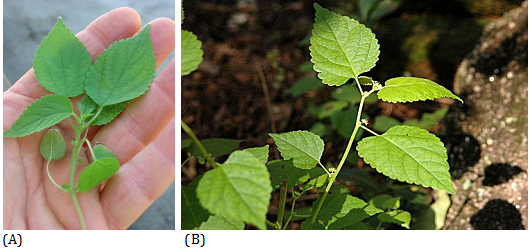Spring 2012 Field Observations
by James A. Bethke
Many people associate invasive pests with unusual or exotic insects — they don’t think of a weed as being invasive. Yet, weeds can easily find their way into the United States as a seed or seedling and go unnoticed — some actually look like the marketable commodity. County inspectors look for specific weeds that are rated Q or A and are known to be a significant pest or invasive.
One such weed caused concern in potted stock that was moved from one county to another and caught. The weed, hairy crabweed (Fatoua villosa) [fig. 1A] ), looked like the seedling of the commodity being shipped, Hawai'i woodnettle (Laportea interrupta [fig. 1B] ). Hairy crabweed is in the Moraceae family, is native to tropical Asia and it is on the CDFA Plant Quarantine Manual’s Q & A rated weed list. The California Weed Law and Noxious Weed List can be found on the CDFA web page for Encycloweedia. Hairy crabweed was found in Los Angeles and San Diego counties. These were very small plants and the situation would have been avoided if the plants had been pulled when found. This is another case illustrating the importance of isolating plants coming in from overseas to avoid having your entire stock put on hold while you wait for a quarantine pest to be eradicated.

Fig. 1. (A) Hairy crabweed (Laportea interrupta) is a noxious weed that was found on a commodity shipping of (B) Hawai'i woodnettle (Laportea interrupta). Although small plants of both species resemble each other, hairy crabweed is in the Urticaceae family and Hawai'i woodnettle is in the Moraceae family.












